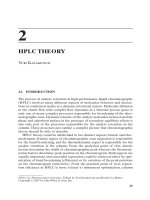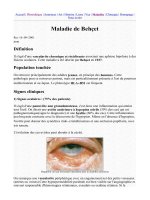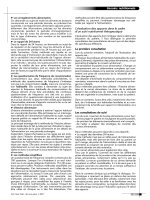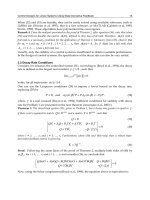Endocrine and Metabolic Emergencies - part 2 pptx
Bạn đang xem bản rút gọn của tài liệu. Xem và tải ngay bản đầy đủ của tài liệu tại đây (326.26 KB, 3 trang )
Dehydration may cause a rise in the plasma levels of routine chemistries
including calcium, protein, amylase, lactate dehydrogenase, transaminases,
and creatinine kinase. Underlying disease states associated with these levels
need to be excluded, however. Patients present with prerenal azotemia, and
the initial BUN to creatinine ratio may exceed 30:1. Leukocytosis is often
present secondary to stress, demarginalization, and hemoconcentration [7].
Infection, however, should be ruled out as the cause of any marked
elevation in white blood cell count. Hemoglobin and hemat ocrit concen-
trations may be elevated falsely because of hemoconcentration, and anemia
should be suspected in a patient with a normal hematocrit on examination
[20].
A mild high anion gap metabolic acidosis, characterized by an arterial pH
above 7.3 and bicarbonate level greater than 15 is common in HHS [22,33].
This acidosis can be multifactorial, contributed to by dehydration, renal
failure, starvation, or mild lactic acidosis. Vomiting or the use of thiazide
diuretics can cause a metabolic alkalosis that can mask the degree of acidosis
[4,12,22]. If acidosis is severe, lactic acidosis caused by hypovolemia and
decreased perfusion, underlying infection, or other concurrent severe illness
(eg, ischemic bowel) should be considered [4]. Arterial blood gas measure-
ments can help clarify what is sometimes a complicated mixed acid base
picture, and indicate other cardiac or pulmonary comorbidities. Although
HHS is de scribed as a nonketotic hyperosmolar state, there is often some
elevation of serum ketones, including b-hydroxybutyrate, which are related
mostly to the starvation ketosis or to dehydration [2,19]. Urinalysis always is
indicated and may demo nstrate some degree of ketonuria also. Gross
proteinuria suggests the presence of underlying renal disease.
Other studies
Other diagnostic studies are obtained routinely in the ED evaluation to
look for precipitating or underlying illnesses. The initial chest radiograph
may be falsely negative for pneumonitis in light of the state of dehydration,
and cardiomegaly in this setting suggests likely cardiomyopathy [19].An
electrocardiogram always is indicated to look for signs of ischemia and
infarction, and acute changes related to electrolyte deficiencies. CT of the
brain to exclude intracranial pathology is indicated because of the frequent
presence of altered cognition. Lumbar puncture and toxicologic studies
should be performed if indicated.
Emergency department management
Management in the ED begins with a rapid clinical assessment focused on
the elements of history and physical, and with appropriate evaluation and
monitoring of respiratory, cardiovascular, and central nervous system
function. The diagnosis of the extreme decompensated diabetic state can be
639HYPEROSMOLAR HYPERGLYCEMIC STATE
Hypothyroidism: Mimicker of Common
Complaints
Matthew C. Tews, DO
a
, Sid M. Shah, MD, FACEP
b,
*
,
Ved V. Gossain, MD, FACP, FACEP
c
a
College of Osteopathic Medicine, Emergency Medicine Residency Program,
Michigan State University–Lansing, P.O. Box 30480, Lansing, MI 48909, USA
b
Michigan State University, Attending Physician Emergency Medicine,
Ingham Regional Medical, Center 401 W. Greenlawn Avenue, Lansing, MI 48910, USA
c
Division of Endocrinology, Department of Medicine, Michigan State University,
Lansing, MI 48909, USA
Patients with hypothyroidism may present with vague symptoms such as
fatigue, arthralgias, myalgias, muscle cramps, headaches, and ‘‘not feeling
well.’’ These are also among the more common complaints encountered by
the emergency physicians. The disease spectrum of hypothyroidism ranges
from an asymptomatic, subclin ical condition to the rare, life-threaten ing
myxedema coma, and thus can be a challenging diagnosis to make. A
progressive and chronic disease, hypothyroidism results from diminished
thyroid hormone production. It slows metabolic functions in every organ
system in the body. Commonly, clinical presentation of hypothyroidism can
be confused with effects of aging in the elderl y, musculoskeletal or
a psychiatric illness such as depression in the younger patients.
Spontaneously occurring hypothyroidism is relatively common, with
prevalence between 1% to 2%, and is 10 times more common in women
than in men [1]. The probability of developing spontaneous hypothyroidism
increases with age, with women having a mean age at diagnosis of around 60
years [2]. A recent survey showed that 9.5% out of nearly 26,000 visitors to
a statewide health fair in Colorado had elevated circulating thyroid
stimulating hormone (TSH) levels, indicating underlying hypothyroidism
[3]. One large study performed in England found the prevalence of
hypothyroidism to be around 18/100 0 women and less than 1/1000 men
in the general population studied [4]. The study also revealed a higher
* Corresponding author.
E-mail address: (S.M. Shah).
0733-8627/05/$ - see front matter Ó 2005 Elsevier Inc. All rights reserved.
doi:10.1016/j.emc.2005.03.013 emed.theclinics.com
Emerg Med Clin N Am 23 (2005) 649–667
Hyperthyroidism
Nathanael J. McKeown, DO
a
, Matthew C. Tews, DO
a
,
Ved V. Gossain, MD, FACP, FACEP
b
,
Sid M. Shah, MD, FACEP
c,
*
a
College of Osteopathic Medicine, Emergency Medicine Residency Program,
Michigan State University, PO Box 30480, Lansing, MI 48909, USA
b
Division of Endocrinology, Department of Medicine, B234 Clinical Center,
138 Service Road, Michigan State University, Lansing, MI 48824, USA
c
Michigan State University, Emergency Medicine, Ingham Regional Medical Center,
401 West Greenlawn, Lansing, MI 48910, USA
Hyperthyroidism is a hypermetabolic state that results from excess
synthesis and release of thyroid hormone from the thyroid gland.
Thyrotoxicosis is a general term referring to all causes of excess thyroid
hormone in the body, including exogenous intake of thyroid hormone
preparations. Although the terms hyperthyroidism and thyrotoxicosis are
by definition not the same, they often are used interchangeably [1].
The clinical spectrum of hyperthyroidism varies from asymptomatic,
subclinical hyperthyroidism to the life-threatening thyroid storm. Sub-
clinical hyperthyroidism is diagnosed in asymptomatic patients on the basis
of abnormal laboratory tests (low thyrotropin [TSH] but normal free T4 and
free T3), and is probably more common than generally believed. Overt
clinical hyperthyroidism presents with typical signs and symptoms. Thyroid
storm is the severe life-threatening form of hyperthyroidism. It usually is
brought about by a precipitating event in patients with undiagnosed or
undertreated hyperthyroidism.
Epidemiology and pathophysiology
The overall incidence of subclinical and overt hyperthyroidism has been
estimated to be 0.05 to 0.1% in the general population [2]. It occurs at all
ages, but it is more common in women than in men. In a recent US study
* Corresponding author.
E-mail address: (S.M. Shah).
0733-8627/05/$ - see front matter Ó 2005 Elsevier Inc. All rights reserved.
doi:10.1016/j.emc.2005.03.002 emed.theclinics.com
Emerg Med Clin N Am 23 (2005) 669–685









